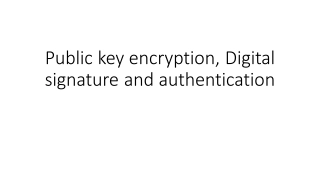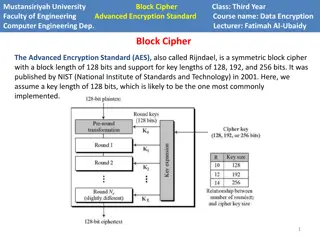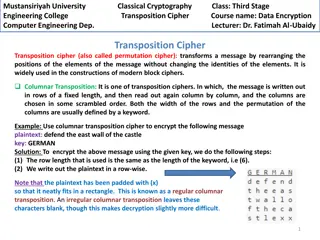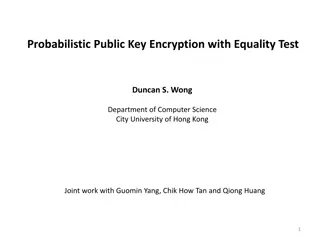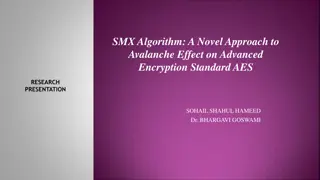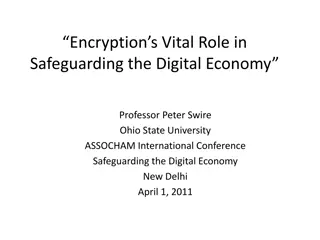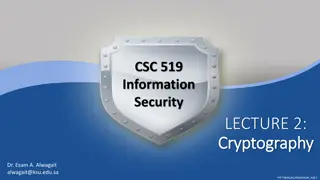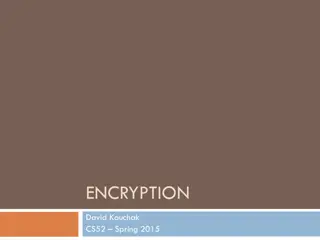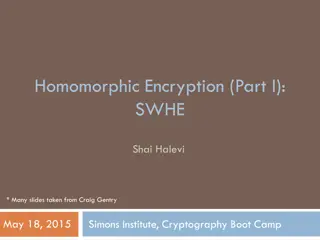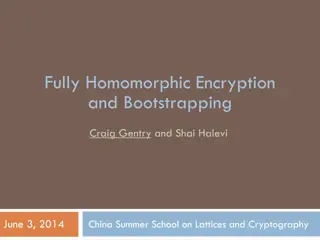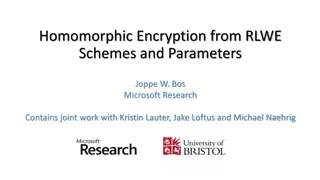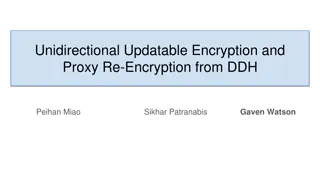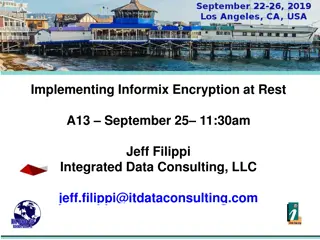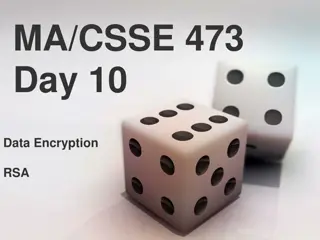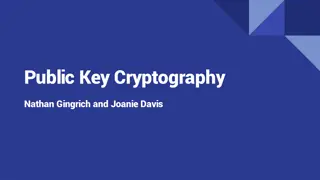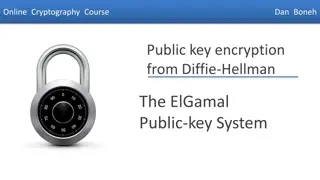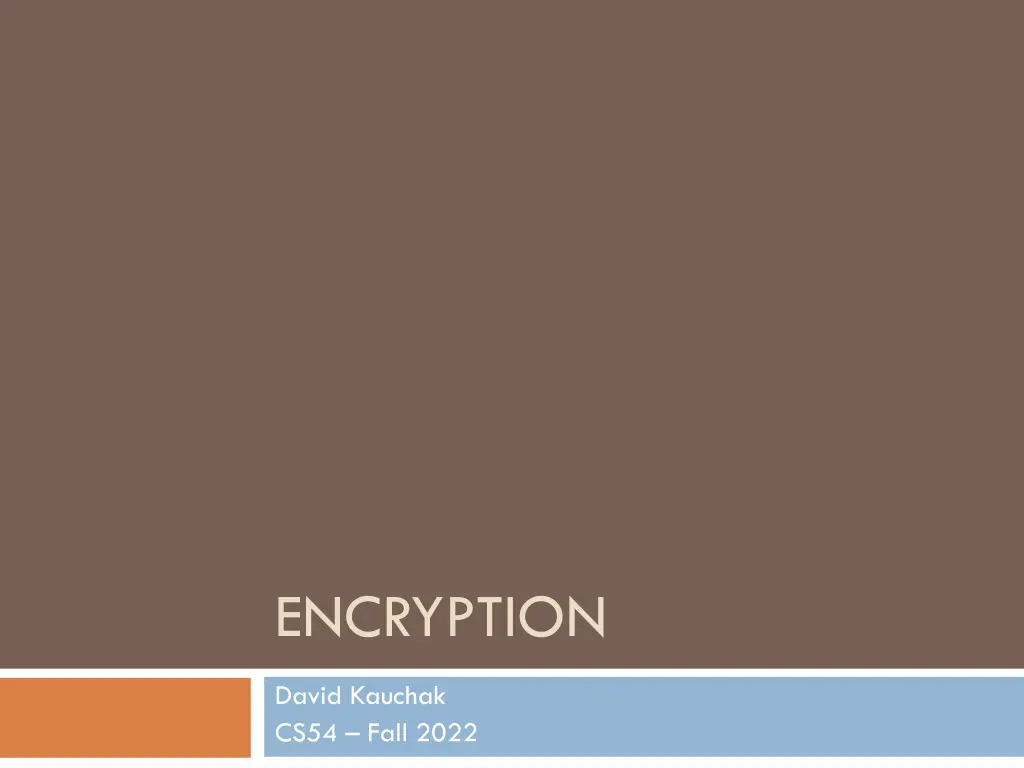
Understanding Encryption and Its Importance
Explore the world of encryption through visuals and descriptions, covering topics like private key encryption, public key encryption, and the basic idea behind encryption techniques. Discover why encryption is crucial for safeguarding data and enabling secure communication in various contexts.
Download Presentation

Please find below an Image/Link to download the presentation.
The content on the website is provided AS IS for your information and personal use only. It may not be sold, licensed, or shared on other websites without obtaining consent from the author. If you encounter any issues during the download, it is possible that the publisher has removed the file from their server.
You are allowed to download the files provided on this website for personal or commercial use, subject to the condition that they are used lawfully. All files are the property of their respective owners.
The content on the website is provided AS IS for your information and personal use only. It may not be sold, licensed, or shared on other websites without obtaining consent from the author.
E N D
Presentation Transcript
ENCRYPTION David Kauchak CS54 Fall 2022
Admin Assignment 5 Assignment 6
Course feedback https://forms.gle/A9KDkC7jxaMsrHn26
Encryption What is it and why do we need it?
Encryption I like bananas
Encryption I like bananas
Encryption: a bad attempt I like bananas
Encryption: the basic idea I like bananas I like bananas decrypt message encrypt message send encrypted message
Encryption: a better approach the hawk sleeps at midnight
Encryption uses Where have you seen encryption used?
Private key encryption I like bananas I like bananas decrypt message encrypt message send encrypted message
Private key encryption Any problems with this?
Public key encryption private key public key Two keys, one you make publicly available and one you keep to yourself
Public key encryption Share your public key with everyone
Public key encryption I like bananas I like bananas decrypt message encrypt message send encrypted message
Public key encryption I like bananas decrypt message Only the person with the private key can decrypt!
Modular arithmetic Normal arithmetic: a = b a is equal to b or a-b = 0 Modular arithmetic: a b (mod n) a-b = n*k for some integer k or a = b + n*k for some integer k or a % n = b % n (where % is the mod operator)
Modular arithmetic Which of these statements are true? 12 5 (mod 7) 52 92 (mod 10) 17 12 (mod 6) a-b = n*k for some integer k or a = b + n*k for some integer k or a % n = b % n (where % is the mod operator) 65 33 (mod 32)
Modular arithmetic Which of these statements are true? 12-5 = 7 = 1*7 12 % 7 = 5 = 5 % 7 12 5 (mod 7) 92-52 = 40 = 4*10 92 % 10 = 2 = 52 % 20 52 92 (mod 10) 17-12 = 5 17 % 6 = 5 12 % 6 = 0 17 12 (mod 6) 65-33 = 32 = 1*32 65 % 32 = 1 = 33 % 32 65 33 (mod 32)
Modular arithmetic properties If: a b (mod n) then: a mod n = b mod n mod /remainder operator congruence (mod n)
Modular arithmetic properties If: a b (mod n) then: a mod n = b mod n More importantly: (a+b) mod n = ((a mod n) + (b mod n)) mod n and (a*b) mod n = ((a mod n) * (b mod n)) mod n What do these say?
Modular arithmetic examples (1712 +1637) mod 10 =
Modular arithmetic examples (1712 +1637) mod 10 = The hard way: 1712 +1637 = 3349 3349 mod 10 = 9
Modular arithmetic examples (1712 +1637) mod 10 = The easy way: 1712 mod 10 + 1637 mod 10 = (2 + 7) mod 10 = 9
Modular arithmetic examples (1712*1637) mod 10 = The easy way: 1712 mod 10 * 1637 mod 10 = (2 * 7) mod 10 = 4 1712*1637 = 2802544 mod 10 = 4
Modular arithmetic Why talk about modular arithmetic and congruence? How is it useful? Why might it be better than normal arithmetic? We can limit the size of the numbers we re dealing with to be at most n (if it gets larger than n at any point, we can always just take the result mod n) The mod operator can be thought of as mapping a number in the range 0 n-1
Modular arithmetic examples (1712237) mod 10 =
Modular arithmetic examples (1712237) mod 10 = The hard way: 2189733188915527033845242014775024662365379214649108861079776729377311646 4178863410200431314724639065631582340030916000535491050743393313989255160 6348256002908856782720027938471702516151831261883438208185382676856143035 8555422262025688935645992713224910081777580598384256361226430744486783684 8972183344917544635567789574283214685603416614354211724441199147585377319 0741448045780204468613804157642484533042787410205542844720697624880058469 5095208486453956254338665468200146017457909832081507762047670719732913228 0181637111587444836647339009142865957557814364142769623374883706605049058 2750630252268175042103727092839763924653863693246547423290880175403121554 3907099468990249536971584503074405804732055649986685982347798454659692375 3074051810350864290528921125484756992 mod 10 2
Modular arithmetic examples (1712237) mod 10 = The easy way: ((1712 mod 10)237) mod 10 = (2237) mod 10 = 2208558830972980411979121875928648 1447843548710945236976520077516157 7472 mod 10 = 2
Modular arithmetic examples (2237) mod 10 = (210 mod 10 * 2227mod 10) mod 10 = (4 * 2227mod 10) mod 10 = (4 * 4 * 2217mod 10) mod 10 = (6 * 2217mod 10) mod 10 = (4 * 2207mod 10) mod 10 =
GCD What does GCD stand for?
Greatest Common Divisor gcd(a, b) is the largest positive integer that divides both numbers without a remainder gcd(25, 15) = ?
Greatest Common Divisor gcd(a, b) is the largest positive integer that divides both numbers without a remainder gcd(25, 15) = 5 15 25 15 25 Divisors: 5 3 1 5 1
Greatest Common Divisor gcd(a, b) is the largest positive integer that divides both numbers without a remainder gcd(100, 52) = ?
Greatest Common Divisor gcd(a, b) is the largest positive integer that divides both numbers without a remainder gcd(100, 52) = 4 52 100 100 50 25 20 10 52 13 Divisors: 4 2 1 5 4 2 1
Greatest Common Divisor gcd(a, b) is the largest positive integer that divides both numbers without a remainder gcd(14, 63) = ? gcd(7, 56) = ? gcd(23, 5) = ? gcd(100, 9) = ? gcd(111, 17) = ?
Greatest Common Divisor gcd(a, b) is the largest positive integer that divides both numbers without a remainder gcd(14, 63) = 7 gcd(7, 56) = 7 gcd(23, 5) = 1 gcd(100, 9) = 1 gcd(111, 17) = 1 Any observations?
Greatest Common Divisor When the gcd = 1, the two numbers share no factors/divisors in common If gcd(a,b) = 1 then a and b are relatively prime This a weaker condition than primality, since any two prime numbers are also relatively prime, but not vice versa
Greatest Common Divisor A useful property: If two numbers, a and b, are relatively prime (i.e. gcd(a,b) = 1), then there exists a c such that a*c mod b = 1
RSA public key encryption Have you heard of it? What does it stand for?
RSA public key encryption RSA is one of the most popular public key encryption algorithms in use RSA = Ron Rivest, Adi Shamir and Leonard Adleman
RSA public key encryption Choose a bit-length k Security increases with the value of k, though so does computation 1. Choose two primes p and q which can be represented with at most k bits 2. Let n = pq and (n) = (p-1)(q-1) () is called Euler s totient function 3. Find d such that 0 < d < n and gcd(d, (n)) = 1 4. Find e such that de mod (n) = 1 Remember, we know one exists! 5.
RSA public key encryption (n) = (p-1)(q-1) d: 0 < d < n and gcd(d, (n)) = 1 e: de mod (n) = 1 p: prime number q: prime number n = pq Given this setup, you can prove that given a number m: (me)d = med = m (mod n) What does this do for us, though?
RSA public key encryption (n) = (p-1)(q-1) d: 0 < d < n and gcd(d, (n)) = 1 e: de mod (n) = 1 p: prime number q: prime number n = pq Given this setup, you can prove that given a number m: m message What does this do for us, though?
RSA public key encryption (n) = (p-1)(q-1) d: 0 < d < n and gcd(d, (n)) = 1 e: de mod (n) = 1 p: prime number q: prime number n = pq Given this setup, you can prove that given a number m: (me) encrypted message What does this do for us, though?
RSA public key encryption (n) = (p-1)(q-1) d: 0 < d < n and gcd(d, (n)) = 1 e: de mod (n) = 1 p: prime number q: prime number n = pq Given this setup, you can prove that given a number m: (me)d = med = m (mod n) decrypted message What does this do for us, though?
RSA public key encryption (n) = (p-1)(q-1) d: 0 < d < n and gcd(d, (n)) = 1 e: de mod (n) = 1 p: prime number q: prime number n = pq private key public key (d, n) (e, n)

